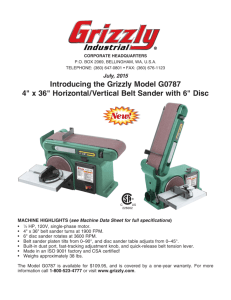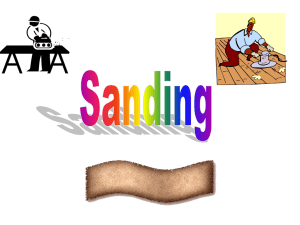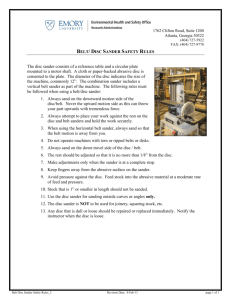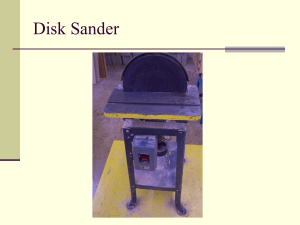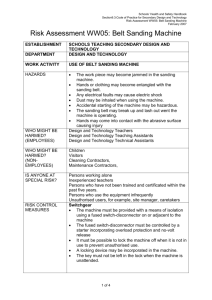belt disc sander
advertisement
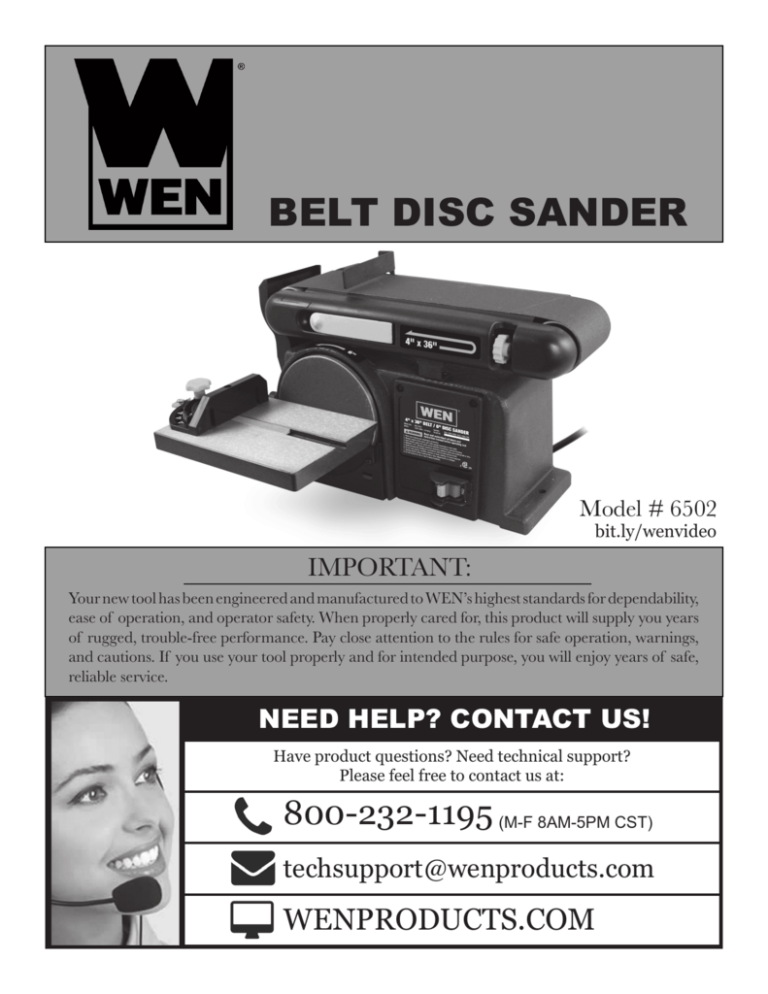
BELT DISC SANDER Model # 6502 bit.ly/wenvideo IMPORTANT: Your new tool has been engineered and manufactured to WEN’s highest standards for dependability, ease of operation, and operator safety. When properly cared for, this product will supply you years of rugged, trouble-free performance. Pay close attention to the rules for safe operation, warnings, and cautions. If you use your tool properly and for intended purpose, you will enjoy years of safe, reliable service. NEED HELP? CONTACT US! Have product questions? Need technical support? Please feel free to contact us at: 800-232-1195 (M-F 8AM-5PM CST) techsupport@wenproducts.com WENPRODUCTS.COM TABLE OF CONTENTS Technical Data General Safety Rules Specific Safety Rules For Belt/Disc Sander Electrical Information Know Your Belt/Disc Sander Assembly and Adjustments Operation Maintenance Troubleshooting Exploded View and Parts List Warranty 2 3 4 6 7 8 12 14 15 17 19 TECHNICAL DATA Model Number: Motor: Speed: Disc Diameter: Belt Size: Belt Speed: Belt Bed Tilt: Belt Grit: Dust Port Size: Net Weight: 2 6502 120 V, 60 Hz, 4.3 A, 1/2 HP 3600 RPM (no load) 6˝ 4˝ x 36˝ 1900 SFM 0 to 90° A80 2-1/4˝ 41 lb GENERAL SAFETY RULES Safety is a combination of common sense, staying alert and knowing how your item works. SAVE THESE SAFETY INSTRUCTIONS. WARNING: To avoid mistakes and serious injury, do not plug in your tool until the following steps have been read and understood. 1. READ and become familiar with this entire instruction manual. LEARN the tool’s applications, limitations, and possible hazards. 2. AVOID DANGEROUS CONDITIONS. Do not use power tools in wet or damp areas or expose them to rain. Keep work areas well lit. 3. DO NOT use power tools in the presence of flammable liquids or gases. 4. ALWAYS keep your work area clean, uncluttered, and well lit. DO NOT work on floor surfaces that are slippery with sawdust or wax. 5. KEEP BYSTANDERS AT A SAFE DISTANCE from the work area, especially when the tool is operating. NEVER allow children or pets near the tool. 6. DO NOT FORCE THE TOOL to do a job for which it was not designed. 7. DRESS FOR SAFETY. Do not wear loose clothing, gloves, neckties, or jewelry (rings, watches, etc.) when operating the tool. Inappropriate clothing and items can get caught in moving parts and draw you in. ALWAYS wear non-slip footwear and tie back long hair. 8. WEAR A FACE MASK OR DUST MASK to fight the dust produced by sawing operations. WARNING: Dust generated from certain materials can be hazardous to your health. Always operate the tool in a well-ventilated area and provide for proper dust removal. Use dust collection systems whenever possible. 9. ALWAYS remove the power cord plug from the electrical outlet when making adjustments, changing parts, cleaning, or working on the tool. 10. KEEP GUARDS IN PLACE AND IN WORKING ORDER. 11. AVOID ACCIDENTAL START-UPS. Make sure the power switch is in the OFF position before plugging in the power cord. 12. REMOVE ADJUSTMENT TOOLS. Always make sure all adjustment tools are removed from the saw before turning it on. 13. NEVER LEAVE A RUNNING TOOL UNATTENDED. Turn the power switch to OFF. Do not leave the tool until it has come to a complete stop. 3 GENERAL SAFETY RULES 14. NEVER STAND ON A TOOL. Serious injury could result if the tool tips or is accidentally hit. DO NOT store anything above or near the tool. 15. DO NOT OVERREACH. Keep proper footing and balance at all times. Wear oil-resistant rubber-soled footwear. Keep the floor clear of oil, scrap, and other debris. 16. MAINTAIN TOOLS PROPERLY. ALWAYS keep tools clean and in good working order. Follow instructions for lubricating and changing accessories. 17. CHECK FOR DAMAGED PARTS. Check for alignment of moving parts, jamming, breakage, improper mounting, or any other conditions that may affect the tool’s operation. Any part that is damaged should be properly repaired or replaced before use. 18. MAKE THE WORKSHOP CHILDPROOF. Use padlocks and master switches and ALWAYS remove starter keys. 19. DO NOT operate the tool if you are under the influence of drugs, alcohol, or medication that may affect your ability to properly use the tool. 20. USE SAFETY GOGGLES AT ALL TIMES that comply with ANSI Z87.1. Normal safety glasses only have impact resistant lenses and are not designed for safety. Wear a face or dust mask when working in a dusty environment. Use ear protection such as plugs or muffs during extended periods of operation. SPECIFIC RULES FOR THE BELT SANDER WARNING: Do not operate this tool until it is completely assembled and installed according to the instructions. 1. This sander is designed to sand wood or wood-like products only. Sanding or grinding other materials could result in fire, injury, or damage to the workpiece. 2. Use the sander on horizontal surfaces only. Operating the sander when mounted on non-horizontal surfaces may result in motor damage or injury. 3. Fasten the sander securely to a bench top or supporting surface in order to stop it from tipping over or moving when in use. 4. Make sure the sanding belt is installed in the correct direction. See directional arrow on back of belt. 5. Always have the tracking adjusted properly so the belt does not run off the pulleys. 6. Do not use sanding belts or discs that are damaged, torn, or loose. Use only correct size sanding belt and disc. 7. Always hold the workpiece firmly when sanding. Keep hands away from sanding belt or disc. Sand only one workpiece at a time. 4 SPECIFIC RULES FOR THE BELT/DISC SANDER 8. Always hold the workpiece firmly on the table when using the disc sander and when using the belt sander. 9. Always sand on the downward side of the sanding disc when using the disc sander. Sanding on the upward side of the disc can cause the workpiece to fly out of position, resulting in injury. 10. Always maintain a minimum clearance of 1/16 inch (1.6 mm) or less between the table or backstop and the sanding belt or disc. 11. Do not sand pieces of material that are too small to be safely supported. 12. When sanding a large workpiece, provide additional table height support. 13. Do not sand with the workpiece unsupported. Support the workpiece with the backstop or table. The only exception is curved work performed on the outer sanding drum. 14. Always remove scrap pieces and other objects from the table, backstop, or belt before turning the sander ON. 15. Never perform layout, assembly or set-up work on the table while the sander is operating. 16. Never use solvents to clean plastic parts. Solvents could dissolve or otherwise damage the material. Use only a soft damp cloth to clean plastic parts. 17. Should any component of your sander be missing/damaged or fail in any way, shut off switch and remove plug from power supply outlet. Replace the missing, damaged, or failed parts before resuming operation. 18. Never pull the power cord out of the receptacle. Keep cords away from heat, oil, and sharp edges. 19. Have an electrician replace or repair damaged or worn cords immediately. ELECTRICAL INFORMATION GROUNDING INSTRUCTIONS IN THE EVENT OF A MALFUNCTION OR BREAKDOWN, grounding provides the path of least resistance for an electric current and reduces the risk of electric shock. This tool is equipped with an electric cord that has an equipment grounding conductor and a grounding plug. The plug MUST be plugged into a matching outlet that is properly installed and grounded in accordance with ALL local codes and ordinances. DO NOT MODIFY THE PLUG PROVIDED. If it will not fit the outlet, have the proper outlet installed by a licensed electrician. IMPROPER CONNECTION of the equipment grounding conductor can result in electric shock. The conductor with the green insulation (with or without yellow stripes) is the equipment grounding conductor. If repair or replacement of the electric cord or plug is necessary, DO NOT connect the equipment grounding conductor to a live terminal. 5 ELECTRICAL INFORMATION CHECK with a licensed electrician or service personnel if you do not completely understand the grounding instructions or whether the tool is properly grounded. USE ONLY THREE-WIRE EXTENSION CORDS that have three-pronged plugs and outlets that accept the tool’s plug as shown in Fig. A. Repair or replace a damaged or worn cord immediately. FIGURE A CAUTION: In all cases, make certain the outlet in question is properly grounded. If you are not sure, have a licensed electrician check the outlet. WARNING: This tool is for indoor use only. Do not expose to rain or use in damp locations. Guidelines for using extension cords Make sure your extension cord is in good condition. When using an extension cord, be sure to use one heavy enough to carry the current your product will draw. An undersized cord will cause a drop in line voltage resulting in loss of power and overheating. The table below shows the correct size to be used according to cord length and nameplate ampere rating. When in doubt, use a heavier cord. The smaller the gauge number, the heavier the cord. Make sure your extension cord is properly wired and in good condition. Always replace a damaged extension cord or have it repaired by a qualified person before using it. AMPERAGE 4.3 A REQUIRED GAUGE FOR EXTENSION CORDS 25 ft. 50 ft. 100 ft. 150 ft. 18 gauge 16 gauge 16 gauge 14 gauge Protect your extension cords from sharp objects, excessive heat and damp/wet areas. Use a separate electrical circuit for your tools. This circuit must not be less than a #12 wire and should be protected with a 15 A time-delayed fuse. Before connecting the motor to the power line, make sure the switch is in the OFF position and the electric current is rated the same as the current stamped on the motor nameplate. Running at a lower voltage will damage the motor. WARNING: This tool must be grounded while in use to protect the operator from electric shock. 6 KNOW YOUR BELT/DISC SANDER ASSEMBLY AND ADJUSTMENTS UNPACKING WARNING: To avoid injury from accidental startups, turn switch OFF and remove the plug from the power source outlet before making any adjustments. Carefully unpack the belt/disc sander and all its parts, and compare against the list below. Do not discard the carton or any packaging until the belt/disc sander is completely assembled. INCLUDES (Fig. 1) 1. Socket Head Screws (2) 2. Miter Gauge (1) 3. Washers (2) 4. Work Support (1) 5. Hex Key 15/64” (1) 6. Worktable (1) 7. Adjustment Knob (1) 7 ASSEMBLY AND ADJUSTMENTS ASSEMBLY INSTALLATION OF SANDING DISC AND GUARD 1. Peel backing away from sanding disc. 2. Align perimeter of disc with plate, and press disc firmly into position on plate, leaving no loose edges. 3. Position disc guard against lower 1/3 of disc, aligning holes as shown. And use a screwdriver to fasten the provided screws and washers securely. MOUNT THE DISC SANDER TABLE 1. With the table in a horizontal position, line up and insert the pivot indexing pin with the pivot hole on the frame. Hold in place. 2. Insert the handle into the threaded hole and tighten. 3. Adjust the table so that the edge is a maximum of 1/16 inch from the disc. Holding the table in this position, tighten the three bolts on the top of the table. WARNING: To avoid trapping the workpiece or fingers between the table and the sanding disc, the table edge should be adjusted to a maximum of 1/16 inch from the sanding disc. 8 ASSEMBLY AND ADJUSTMENTS MOUNTING THE WORK SUPPORT 1. Align the Work Support with the hole. 2. Install a Lock Washer and a Flat Washer on the Hex Screw. 3. Insert the Hex Screw into the Work Support hole. Tighten. 4. Adjust the Work Support height to avoid contact with the sanding belt. MOUNTING THE SANDER TO WORKBENCH WARNING - If during operation there is any tendency for the sander to tip over, slide or walk on the supporting surface, the sander should be properly mounted to a workbench or stand. 1. Position the sander on the workbench where you expect/intend to use it. 2. Mark the workbench through the mounting holes located in the sander base. Drill holes in the workbench at the marks. 3. Using long bolts, washers, locking washers and nuts as shown (not supplied), secure the sander to the workbench. Note: All bolts should be inserted from the top. Washers and hex nuts should be fastened from the underside of the workbench. INSTALL THE SANDING BELT 1. Loosen the bed locking screw with the hex key. Raise the sanding bed about 45°; tighten the bed locking screw. 2. Pull the tension lever, releasing the tension. 3. Locate the directional arrow on the smooth side of the sanding belt. 4. Place the sanding belt over the drums with the directional arrow pointing towards the dust chute. 5. Center the belt correctly on both drums. 6. Push the tension lever back to tighten the belt to the bed. 7. Loosen the bed locking screw; lower the bed to a horizontal position. Tighten the bed locking screw. 99 ASSEMBLY AND ADJUSTMENTS SANDING BELT TRACKING ADJUSTMENT 1. Plug in the power cord. 2. Turn the switch ON and OFF to make sure the sanding belt is correctly centered and not sliding off the idler and drive roller drums. a. If the sanding belt moves toward the disc, slightly turn the tracking knob counterclockwise. b. If the sanding belt moves away from the disc, slightly turn the tracking knob clockwise. 3. Turn the switch ON and OFF again; readjust the tracking knob if necessary. CHANGE SANDING BELT BED POSITION The sanding bed can be used in the horizontal or vertical positions or any angle in between. To use in the vertical position, do the following: 1. Loosen the bed locking screw with hex key, move the bed to the desired vertical position. 2. Tighten the locking screw when at desired position. DUST PORT OPERATION The dust port can be easily connected to a large diameter shop vacuum hose. Sanding operations are inherently dusty. To help minimize the amount of dust that escapes into the surrounding air, this sander is equipped with a 2-1/4” dust chute that can be easily connected to a dust-collection system. It is strongly recommended that users employ a dust-collection system when using this belt & disc sander. Use of a mask or respirator is still recommended even when a dust-collection system is in use. INSTALL A NEW SANDING DISC 1. Remove the two screws from the sanding disc guard and remove the guard. 2. Remove the used sanding disc. 3. Wipe the sanding disc plate clean. 4. Peel the backing from the new sanding disc, align the disc with the plate and press the sanding disc firmly on to the plate. 5. Reinstall the disc guard and tighten the screws. 10 ASSEMBLY AND ADJUSTMENTS SQUARE THE TABLE To ensure accurate end sanding, the work tables must be square to the sanding surfaces prior to using the tables for disc sanding. 1. Adjust the table to be 90° with the sanding surface. 2. Using a combination square (1), place one end on the table with the ruler end against the sanding surface (3). Check that the table is 90° to the sanding surface. 3. If the table is not 90° to the sanding surface, loosen the handle (4), adjust the table, tighten the handle and recheck with the square. SQUARE THE WORK SUPPORT The work support (2) must be square to the sanding belt when using the belt sander in a horizontal position. To keep the workpiece from being carried along the belt: 1. Make sure the sanding belt is tight; also check that the tension lever is fully tightened. 2. Place the combination square (1) on the belt with the ruler against the work support (2). 3. Adjust by loosening the work support locking screw (3), square the work support. 4. Tighten the work support locking screw (3). 11 OPERATION ON/OFF SWITCH The keyed switch is intended to prevent unauthorized use of the sander. WARNING: Remove the safety key whenever the sander is not in use. Place the key in a safe place and out of the reach of children. 1. To turn sander ON, insert the safety key (1) into the key slot (2) in the center of the switch. 2. Push key firmly into the slot, then push switch to the ON position to start the sander. 3. To turn the sander OFF push switch to the OFF position. 4. Remove the safety key when the sander has come to a complete stop by gently pulling it forward and out. SURFACE SANDING ON SANDING BELT Hold the workpiece firmly with both hands. Keep fingers away from sanding belt. Keep the workpiece end against the backstop and move it slowly across the sanding belt. Apply enough pressure to remove material; excessive pressure will reduce sanding efficiency. SANDING INSIDE CURVES When sanding inside-curves on the belt-sander, always sand on the idler drum end of the work support station (right side of the machine as shown in diagram). Hold the workpiece firmly, keeping fingers away from the sanding belt. Keep the curve pressed firmly against the idler drum, moving the work evenly back and forth across the drum. Note: Use extra caution when sanding very thin pieces, and apply only enough pressure to allow the sanding belt to remove the material. 12 OPERATION END SANDING AND OUTSIDE CURVE SANDING WITH THE DISC Use for sanding the ends of small and narrow workpieces and outside curved edges. Always work on the left side of the disc (downward rotation side), holding the workpiece firmly with light pressure against the sanding disc. CAUTION: To avoid personal injury and/or damage to the workpiece, become familiar with the rotation of the belt and disc sanding surfaces. The belt sander rotates counterclockwise or downward toward the table or backstop. The disc sander rotates counterclockwise, downward toward the table on the left side of the disc and upward from the table on the right side of the disc. Always use the left side of the disc; using the right side of the disc will cause the workpiece to fly up or kickback and could result in injury. Review this instruction manual for correct operation, adjustments, and basic sanding operations. BELT SANDER - HORIZONTAL AND VERTICAL SANDING Your belt & disc sander can sand vertically as well as horizontally. Depending on the operator’s needs and the workpiece, the work-support can be used with either the horizontal or vertical position. To change from one position to the other: 1. Locate the 15/64” (6 mm) hex wrench 2. Loosen the bed-locking hex-socket screw by turning it counter-clockwise. 3. Manually move the work support station into the vertical or horizontal position, as required. 4. Retighten the bed-locking hex-socket screw by turning it clockwise (using the 15/64” (6 mm) hex wrench). Operational Note: Sand long workpieces with the sanding belt in the vertical position by moving the work evenly across the sanding belt. 13 OPERATION MITER GAUGE - DISC SANDER A miter-gauge is supplied with your sander, and can be used on the disc table. The miter gauge head can be set anywhere up to 60º (right or left) by loosening the lock-knob, setting the miter gauge head to the desired angle, and retightening the lock-knob. SANDING SMALL END GRAIN AND OTHER SMALL SURFACES USING MITER GAUGE Use of the miter gauge is recommended for sanding small end surfaces on the sanding disc. Note: Always move the workpiece across the sanding disc from the left side towards the right side, and be sure to hold the workpiece down tightly onto the table surface. MAINTENANCE WARNING: For your own safety, turn the switch OFF and remove the plug from the electrical outlet before adjusting or performing maintenance or lubrication work on the belt/disc sander. Before using, check to make sure parts are not damaged, missing, or worn. Check for alignment of moving parts, binding of moving parts, improper mounting, or any other conditions that may affect the sander operation. If any of these conditions exist, do not use the sander until parts are replaced or the sander is properly repaired. Frequently blow or vacuum dust from all sanding parts and motor housing. WARNING: Any attempt to repair or replace electrical parts on this tool may be hazardous. Repairs should be done by a qualified service technician. LUBRICATION Ball bearings are grease packed at the factory and require no further lubrication. Use a spray lubricant on all moving table parts to ensure smooth operation. ADJUST THE DRIVE BELT 1. Remove the drive belt housing cover (1). 2. Loosen the 3 screws (2) allowing the pulley to slip and the drive belt (3) to loosen. The drive belt should be seated correctly in the motor pulley and the drive pulley. 3. Adjust the tension of the belt by putting a slotted screwdriver in the bracing slot (4). Pushing up on the screwdriver will tighten the tension of the belt between the pulleys. 4. Tighten all 3 screws (2). 5. Test belt tension by squeezing both sides of the belt. If properly adjusted, the belt should “give” between 1/8–1/4 inch (3–6 mm). Make sure that the belt teeth are properly seated in the pulley gears. 6. Carefully reinstall the drive belt housing cover (1). Insert and tighten screw. Note: Excessive tightness on the pulley belt will cause increased noise and motor overload. Premature failure will occur if belt is too loose. 14 TROUBLESHOOTING PROBLEM Sanding grains easily rub off belt or discs Deep sanding grooves or scars in workpiece. CAUSE 1) Sanding belt/disc has been stored in an incorect environment. 2) Sanding belt/disc has been damaged or folded. 1) Sanding belt/disc grit is too coarse for the desired finish. 2) Workpiece sanded across the grain. 3) Too much sanding force on workpiece. 4) Workpiece held still against belt-disc for too long. Sanding 1) Too much pressure against belt/disc surface clogs 2) Sanding softwood. quickly Burns on workpiece 1) Use a sanding grit that is too fine. 2) Using too much pressure. 3) Work held still for too long. Motor will not start— fuses or circuit breakers tripping/ blowing Motor overheats 1) Short circuit in line, cord or plug. 2) Short circuit in motor or loose connections 3) Incorrect fuses or circuit breakers in power line. Motor stalls (resulting in blown fuses or tripped circuit) 1) Short circuit in motor or loose connections. 2) Low voltage. 3) Incorrect fuses or circuit breakers in power line. 4) Motor overload. 1) Motor overloaded 2) Extension cord too long with an insufficient gauge. SOLUTION 1) Store sanding accessories away from extremely hot/dry tempuratures. 2) Store sanding accessories flat—not bent or folded. 1) Use a finer-grit sanding accessory. 2) Sand with the grain of the wood. 3) Reduce pressure on workpiece while sanding. 4) Keep workpiece moving while sanding on the sanding accessory. 1) Reduce pressure on workpiece while sanding. 2) Use differents stock/sanding accessories, or accept that this will happen and plan on cleaning or replacing belts/discs frequently. 1) Use a coarser-grit sanding accessory. 2) Reduce sanding pressure on workpiece 3) Do not keep workpiece in one place for too long. 1) Inspect cord or plug for damaged insulation and shorted wires. 2) Inspect all connections on motor for loose or shorted terminals and/or worn insulation. 3) Install correct fuses or circuit breakers or switch tool to an appropriately sized circuit. 1) Reduce load on motor (pressure on object being sanded) 2) Utilize an extension cord of appropriate gauge and length or plug tool directly into outlet. 1) Inspect connections on motor for loose or shorted terminals or worn insulations. 2) Correct low voltage conditions (for example: improper extension cord length and/or gauge). 3) Install CORRECT fuses or circuit breakers or plug tool into an appropriate circuit, matched to an appropriate fuse or breaker. 4) Reduce the load on the motor. 15 TROUBLESHOOTING PROBLEM CAUSE Machine 1) Incorrect motor mounting. vibrates 2) Incorrect sanding-belt tension. excessively 3) Weak or broken tension spring. 4) Idler roller is too loose. 5) Broken/defective sanding accessories. SOLUTION 1) Have motor mountings inspected by service technician. 2) Adjust tension adjustment knob. Follow belttensioning/ tracking instructions in this manual. 3) Have tension spring replaced by service technician. 4) Have service technician adjust idler roller. 5) Replace sanding belt/disc. Workpiece 1) Not supporting the workpiece against the 1) Use the platen (backstop) or mitre gauge to supfrequently stop. port the workpiece. gets pulled 2) Attempting to sand (unaided) a work2) Use another hand tool or jig to grasp or hold the out of opera- piece that is too small. workpiece. tor’s hands Workpiece Sanding on the “up” side of the wheel. Sand on right side of sanding disc (as operator lifts up from faces the disc). the sanding disc/table. Machine 1) Feed rate too great. 1) Reduce the rate at which the workpiece is fed slows when 2) Use of undersized circuit or extension into the working area of the tool. operating cord. 2) Ensure circuit wires or extension cords are proper gauge, or eliminate use of extension cords. 16 EXPLODED VIEW AND PARTS LIST 17 EXPLODED VIEW AND PARTS LIST Item # 1 2 3 4 5 6 7 8 9 10 11 12 13 14 15 16 17 18 19 20 21 22 23 24 25 26 27 28 29 30 31 32 33 34 35 36 37 38 39 40 41 42 43 44 45 46 18 Stock # 90228-001 90228-012 90228-003 90228-004 90228-015 90228-006 90228-007 90228-008 90228-009 90228-010 90228-011 90228-012 90228-014 90228-026 90228-015 6502-016 90228-017 6502-018 90228-019 90228-020 90228-021 90228-022 6502-023 90228-024 90228-023 90228-026 90228-027 90228-028 90228-029 90228-023 90228-031 90228-032 90228-033 90228-034 90228-035 6502-036 6502-037 6502-038 6502-039 90228-037 90228-038 90228-039 6502-043 6502-044 6502-045 6502-046 Description Screw M4x6 Screw M4x8 Base Cover Screw ST4.2x10 Lock Washer 4 Disc Cover Disc Paper 80# Screw M6x16 Lock Washer 5 Disc Sanding Disc Guard Screw M5x8 Flat washer 5 Flat washer 5 Lock Washer 5 Pin Roll 5x10 Base Cord Clip Wire Connection Box Cover Screw ST2.9x30 Relay Wire Connection Box Glass Tube Power Switch Screw M4x10 Spring Washer 6 Hex Nut M5 Capacitor Capacitor Support Screw M5x12 Bolt M6x12 Washer 6 Work Table Support Angle Plate Miter Gauge Knob Work Table Miter Gauge Bar Point of Miter Gauge Miter Gauge of Work Table Cotter Tension Spring Bushing Belt Tension Support Tetaining Ring Bearing Idler Drum Idler Shaft Item # 47 48 49 50 51 52 53 54 55 57 58 59 60 61 62 63 64 65 66 67 68 69 70 71 72 73 74 75 76 77 78 81 82 83 84 85 86 87 88 89 90 91 92 94 95 96 Stock # 90228-040 6502-048 6502-049 6502-050 6502-051 6502-052 90228-046 90228-047 90228-048 90228-050 90228-051 90228-052 90228-053 90228-084 6502-062 6502-063 90228-054 90228-055 90228-056 90228-057 90228-058 90228-059 90228-060 90228-061 90228-062 90228-063 90228-064 90228-065 90228-066 90228-067 90228-068 90228-071 90228-072 90228-077 90228-073 90228-075 90228-076 90228-079 90228-080 6502-089 6502-090 90228-018 90228-078 90228-012 90228-040 6502-096 Description Screw M5x20 Bushing Connection Rod Extension Spring Belt Tension Knob Big flat washer D5 Hex Bolt M6x20 Screw M5x16 Adjust Knob Rubber Washer Adjust Spring Belt Support Work Rest Driving Roller Assembly Screw M8x12 Driving Pulley Shaft Bearing Cap Support Cover Screw M5x10 Cog Belt Guard Cover Screw M5x16 Special Locked Washer Cog Belt Driven Pulley Screw M5x25 Bearing Base Screw M6x25 Screw M8X25 Cog Belt Guard Cover Square Nut Driving Pulley Motor Assembly Power Cord Switch Protect Cover Dust Collection Port Belt Frame Support Belt Paper 80# Flat Washer 8 Screw M8x16 Tension Rod Pin Roll 5x8 Screw ST4.2x20 ScrewST2.9x8 Screw M5x25 Screw M5x20 Ground Connection Lug LIMITED TWO YEAR WARRANTY WEN Products is committed to building tools that are dependable for years. Our warranties are consistent with this commitment and our dedication to quality. LIMITED WARRANTY OF WEN CONSUMER POWER TOOLS PRODUCTS FOR HOME USE GREAT LAKES TECHNOLOGIES, LLC (“Seller”) warrants to the original purchaser only, that all WEN consumer power tools will be free from defects in material or workmanship for a period of two (2) years from date of purchase. Ninety days for all WEN products, if the tool is used for professional use. SELLER’S SOLE OBLIGATION AND YOUR EXCLUSIVE REMEDY under this Limited Warranty and, to the extent permitted by law, any warranty or condition implied by law, shall be the repair or replacement of parts, without charge, which are defective in material or workmanship and which have not been misused, carelessly handled, or misrepaired by persons other than Seller or Authorized Service Center. To make a claim under this Limited Warranty, you must return the complete power tool product; transportation prepaid, to Great Lakes Technologies, LLC – 1675 Holmes Road – Elgin, IL. 60123 with a copy of the original receipt which is legible and clearly defines Date of Purchase including month and year and Place of Purchase. THIS LIMITED WARRANTY DOES NOT APPLY TO ACCESSORY ITEMS SUCH AS CIRCULAR SAW BLADES, DRILL BITS, ROUTER BITS, JIGSAW BLADES, SANDING BELTS, GRINDING WHEELS AND OTHER RELATED ITEMS. ANY IMPLIED WARRANTIES SHALL BE LIMITED IN DURATION TO TWO (2) YEARS FROM DATE OF PURCHASE. SOME STATES IN THE U.S., SOME CANADIAN PROVINCES DO NOT ALLOW LIMITATIONS ON HOW LONG AN IMPLIED WARRANTY LASTS, SO THE ABOVE LIMITATION MAY NOT APPLY TO YOU. IN NO EVENT SHALL SELLER BE LIABLE FOR ANY INCIDENTAL OR CONSEQUENTIAL DAMAGES (INCLUDING BUT NOT LIMITED TO LIABILITY FOR LOSS OF PROFITS) ARISING FROM THE SALE OR USE OF THIS PRODUCT. SOME STATES IN THE U.S. AND SOME CANADIAN PROVINCES DO NOT ALLOW THE EXCLUSION OR LIMITATION OF INCIDENTAL OR CONSEQUENTIAL DAMAGES, SO THE ABOVE LIMITATION OR EXCLUSION MAY NOT APPLY TO YOU. THIS LIMITED WARRANTY GIVES YOU SPECIFIC LEGAL RIGHTS, AND YOU MAY ALSO HAVE OTHER RIGHTS WHICH VARY FROM STATE TO STATE IN THE U.S., PROVINCE TO PROVINCE IN CANADA AND FROM COUNTRY TO COUNTRY. THIS LIMITED WARRANTY APPLIES ONLY TO PORTABLE ELECTRIC TOOLS, BENCH POWER TOOLS, OUTDOOR POWER EQUIPMENT AND PNEUMATIC TOOLS SOLD WITHIN THE UNITED STATES OF AMERICA, CANADA AND THE COMMONWEALTH OF PUERTO RICO. FOR WARRANTY COVERAGE WITHIN OTHER COUNTRIES, CONTACT THE WEN CUSTOMER SUPPORT LINE. 19
